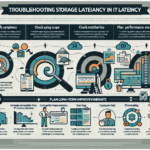Troubleshooting storage replication delays in an IT infrastructure environment requires a systematic approach to identify and resolve the underlying issues. As an IT manager responsible for datacenter operations, here is a step-by-step guide to help you troubleshoot storage replication delays:
Step 1: Gather Information
- Understand the Scope of the Issue:
- Which systems or applications are affected?
- Is the delay occurring during specific times or consistently?
-
What is the replication technology being used (e.g., SAN replication, NAS replication, object storage replication, or software-defined storage solutions)?
-
Document Current Performance Metrics:
- Replication latency (e.g., round-trip time, bandwidth usage).
- Throughput (data transfer rate).
-
Error logs or alerts from storage systems.
-
Understand the Replication Setup:
- Is it asynchronous or synchronous replication?
- What are the source and destination storage systems and their configurations?
Step 2: Analyze the Network
- Check Network Bandwidth and Congestion:
- Verify if the network link between source and destination storage systems has sufficient bandwidth for replication.
-
Use tools like iperf to measure network performance.
-
Monitor Network Latency:
-
High latency can delay replication. Use tools like ping, traceroute, or network monitoring software (e.g., SolarWinds, PRTG) to identify bottlenecks.
-
Inspect Network Errors and Packet Loss:
- Review switch/router logs for dropped packets or errors.
-
Ensure that Quality of Service (QoS) is configured to prioritize replication traffic, if needed.
-
Check Firewall or Security Settings:
- Ensure that replication ports/protocols are not being blocked or throttled by firewalls or security appliances.
Step 3: Assess Storage System Health
- Verify Storage Performance:
- Check disk latency, IOPS (Input/Output Operations per Second), and throughput on both source and destination storage systems.
-
Look for overloaded disks or RAID arrays.
-
Review Storage Utilization:
-
Ensure that source and destination storage have sufficient free space and are not running at capacity.
-
Examine Storage Controller Load:
-
Overloaded storage controllers can slow down replication. Check CPU, memory, and cache usage on the storage systems.
-
Inspect Storage Replication Logs:
- Look for errors or warnings related to replication processes (e.g., failed snapshots, timeout issues).
Step 4: Examine Replication Configuration
- Check Replication Settings:
- Ensure that replication schedules and policies are configured correctly.
-
Verify if replication jobs are queuing up or failing.
-
Optimize Chunk Sizes:
-
Some replication solutions allow configuration of chunk/block sizes for data transfers. Smaller chunks may improve efficiency, but larger chunks may reduce overhead.
-
Inspect Compression and Encryption Settings:
-
If compression or encryption is enabled for replication, ensure that these settings are optimized. Excessive overhead can slow replication.
-
Review Replication Consistency Mode:
- For synchronous replication, delays may be due to strict consistency requirements. If latency is a concern, consider switching to asynchronous replication (if acceptable).
Step 5: Investigate Host and Virtualization Impact
- Check Host Resource Usage:
-
Ensure that hosts sending or receiving replication data have adequate CPU, memory, and network resources.
-
Inspect Virtualization Layer:
-
If using virtualized storage (e.g., VMware vSAN, Nutanix), check hypervisor resource contention or misconfiguration.
-
Confirm Snapshot Management:
- Excessive snapshots or old snapshot chains can slow replication in virtualized environments.
Step 6: Test and Validate Changes
- Run Test Replication Jobs:
- Perform replication tests during off-peak hours to isolate issues.
-
Measure performance before and after configuration changes.
-
Monitor Impact of Changes:
- Use monitoring tools (e.g., Grafana, Prometheus, or vendor-specific dashboards) to track replication performance improvements.
Step 7: Escalate to Vendor Support
- Contact Storage Vendor:
-
If the issue persists, open a support ticket with the storage vendor. Provide detailed logs, metrics, and troubleshooting steps performed.
-
Review Vendor Firmware or Updates:
- Check for firmware or software updates that may address known replication issues.
Step 8: Plan for Long-Term Improvement
- Upgrade Network Infrastructure:
-
Consider upgrading network links between data centers (e.g., increase bandwidth or move to dedicated replication links).
-
Scale Storage Systems:
-
Add additional storage resources (e.g., disks, controllers) if the current storage is underprovisioned.
-
Implement Monitoring Tools:
-
Deploy advanced monitoring tools to proactively identify replication delays (e.g., vRealize Operations, Nagios, or vendor-specific monitoring solutions).
-
Review Disaster Recovery Strategy:
- Evaluate whether the replication setup meets RTO (Recovery Time Objective) and RPO (Recovery Point Objective) requirements for your organization.
By following this approach, you should be able to systematically identify and resolve storage replication delays, ensuring smooth operations across your IT infrastructure.


